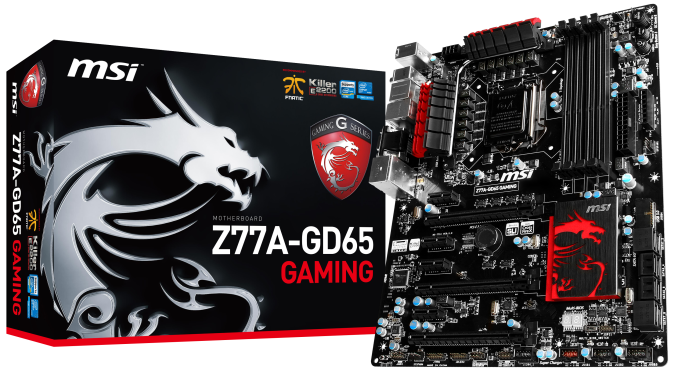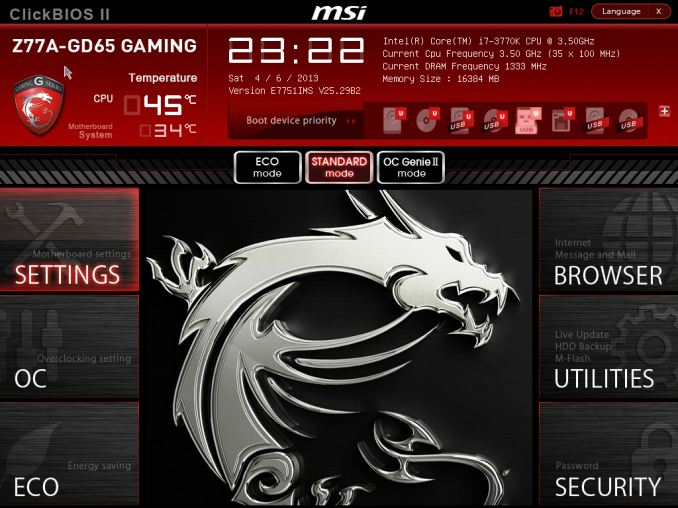MSI Z77A-GD65 Gaming Review
by Ian Cutress on April 18, 2013 12:00 PM EST- Posted in
- Motherboards
- MSI
- Z77
When a product on the market promotes itself as a gaming tool, it cannot just be part of the name or the branding. The product has to showcase why it is a gaming product, and why it is so deserving of our money above and beyond the standard product grade. Associating the product with professional gamers and marketing strongly are worth nothing if the product itself is a poor shell of what is actually good for gamers. Out with the fluff, in with what the real world needs and wants.
It is hard to judge where the MSI Z77A-GD65 Gaming sits on this proverbial spectrum – in almost every way it is the standard Z77A-GD65. What makes it different is the Killer NIC for reduced lag, the gaming port (that has no associated software to make sure it is enabled), and the dragon styling, covering the shape of the VRM heatsink, the chipset heatsink, the BIOS and various elements of the software stack.
The price for all this benefit over the standard model is $15-$30 (when the GD65 is on sale), which is excruciatingly high considering the standard GD65 can be had at common retailers for only $150. For that extra I would want some extra box bonuses, or additional USB 3.0 controllers, or dual NICs, or WiFi, or anything!
Despite all this, the Gaming variant does a better than average job in our benchmark suite. While it seems very power efficient at idle, it starts to approach the higher end when going all out in our gaming suite; performance is better than average, but nothing spectacular especially if a user plans to overclock. The main plus in MSI’s arsenal is Live Update 5, which is great from the ‘keeping up-to-date’ point of view – but all MSI motherboards have this.
The overclocking options, while numerate, are awkward to work with due to any sense of order. I am a big fan of having an easy one button overclock, but the option of an array of one-button overclock modes should the user want to go further. An auto overclock to 4.2 GHz is rather poor given that almost every 3770K sample should hit 4.4 GHz. Why not have two or three options for those that have compatible processors?
Ultimately the Z77A-GD65 Gaming feels a little rushed and out of place, firstly because MSI was planning to release their first gaming boards with Haswell until the Haswell delay, but also because the Z77A-GD65 exists and offers mostly the same functionality for $15-30 less.
Our best ATX board at $180 has been the Gigabyte Z77X-UD5H (bronze award), which features 10 USB 3.0 ports, an mSATA, dual NIC (Intel+Realtek), an included USB 3.0 bracket, and software that offers more auto-overclock options. Is it worth missing on that for dragon styling and a gaming NIC?












37 Comments
View All Comments
jabber - Thursday, April 18, 2013 - link
Yes a shame about those unwanted video ports. Just more unnecessary circuit traces on a very busy board.iamkyle - Thursday, April 18, 2013 - link
I'm still waiting for a manufacturer to come out with an E-ATX or XL-ATX motherboard that sacrifices the onboard junk - audio, LAN, etc and just gives me the bare essentials. Just give me USB ports and let me build the rest.With those motherboard form factors, there is PLENTY of room for 'enthusiasts' to use 3 or 4-way SLI or CF setups and STILL use a premium sound card or NIC of their choice. TRUE customizability, TRUE choice.
jabber - Thursday, April 18, 2013 - link
Yes I've always wanted a motherboard that really strips away everything an enthusiast wouldn't want. I'm pretty sure with less crap on the board it would have less noise and the traces could be shortened and widened improving stability and OC potential.TaylorSandler - Thursday, April 18, 2013 - link
Love my job, since I've been bringing in $5600… I sit at home, music playing while I work in front of my new iMac that I got now that I'm making it online.(Click Home information)http://goo.gl/dkKvy
dawp - Friday, April 19, 2013 - link
why can't we flag spammers?whyso - Thursday, April 18, 2013 - link
Why are POST times so long on desktop boards. For laptops its generally less than five seconds.Death666Angel - Thursday, April 18, 2013 - link
Because desktop boards typically include a bunch more extra hardware (USB chips, SATA chips, bigger BIOS, more memory modules etc.) and all that takes time to initialize. Laptop motherboards on the other hand are usually pretty bare bones utilizing only chipset features and not much more, the BIOS is also fairly locked down and offers only basic customization and the builder knows what will be included in the built so there is no need to search for a lot of stuff that might be installed, which shaves off even more time.IanCutress - Friday, April 19, 2013 - link
Usually due to initialisation processes. I test POST with two GPUs under Win7, and each GPU adds some time. There's also more fan controllers, headers, ports, and all the stuff connected to the chipset that you don't get in a laptop, hence the big discrepancy in time. Death Angel covers it ^^^TGressus - Thursday, April 18, 2013 - link
I've always liked the look of the Tantalum capacitors MSI uses. They should switch the remaining SMD caps out, blacken the silk screening, lead and solder.It would take extreme aesthetic to offset MSI BIOS. :(
Quizzical - Thursday, April 18, 2013 - link
"gaming WiFi" is an oxymoron, so I don't think you can reasonably fault MSI for not including it.If the GD65 is the flagship of MSI's "gaming" line and the rest have numbers that normally correspond to MSI's lower end motherboards, then they may well be taking the approach of saying, let's include the stuff that gamers need and not so much else, rather than spending the money for worthless junk like a Thunderbolt port.
There are plenty of people who want to build a gaming rig with a sub-$100 motherboard for budget reasons, though on such a budget, you're probably looking at an AMD CPU. A motherboard that offers everything that has a plausible gaming use and not much else could have a useful niche.
-----
The utility of a higher polling rate mouse has nothing to do with the frame rate. There's no good reason for a game engine to pretend that all inputs happened exactly when a new frame started. You process keyboard, mouse, and gamepad inputs as they come in, and if you don't start a new frame until 10 ms after you found out that a button was pressed, then that frame can show 10 ms worth of movement due to the button press.
A higher polling rate does only take a few ms off of input latency. Windows default for USB devices is 125 Hz, which means average input latency of 4 ms (on average, you press a button halfway between the next time that the device will be polled and the previous time), and that trivially can't be reduced to less than 0 ms.